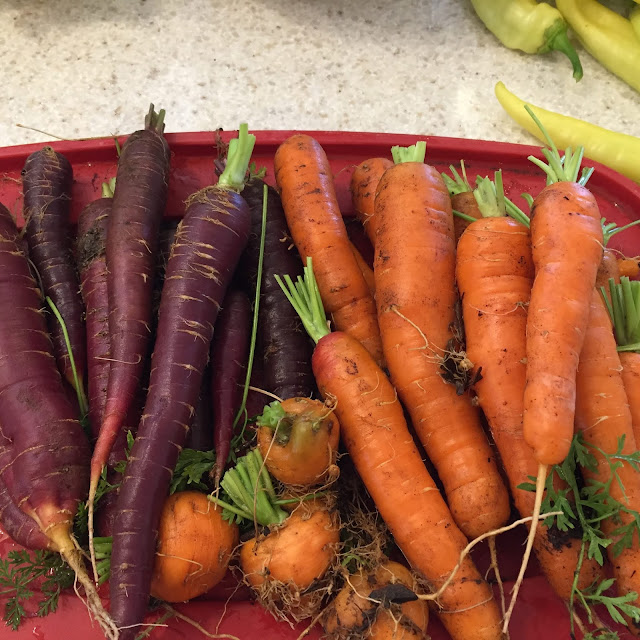Carrots
I love digging carrots. The smell of rich fertile soil and the sweet aroma makes digging these bright orange or deep purple tapered roots enjoyable. After growing your own carrots, store bought carrots will seem bland and mealy. A fresh carrot is sweet and so crisp. This is one versatile crop I can't plant enough of.Tips for Growing Great Carrots
- Carrots grow best in a soil free of clods and stones. The roots twist if the soil is rocky.
- Incorporate lots of organic matter.
- Do not use fresh manure it causes hairy roots.
- Excessive nitrogen will also cause hairy roots.
- Moisture fluctuations cause root disorders, slow leaf development, and bitterness.
- Carrots germinate best when soil temperatures are 55-65
- Poor germination results if temperatures are above 80 degrees
- Carrots taste and grow best if they mature quickly before the heat of summer.
- They do not like to be water stressed and need thorough watering
Planting:
Some people have difficulty getting carrots to germinate. They can be a bit temperamental. Carrots need to be planted shallow and kept moist. They are slow to germinate. Plant by mixing with sand or peat moss and broadcasting over the soil. This method will require thinning. If you are not a fan of thinning then run your finger in a line in the soil. Sprinkle seeds in tiny little furrow you made and gently brush a little soil over seeds. Do not plant too deeply. The seeds will not germinate if allowed to dry out so water frequently especially on a windy day. This is what makes them temperamental especially if you have winds that dry out the top layer of soil. To prevent drying out it is helpful to cover the area with a row cover or weed clothe until germination. You can water right over the clothe. Just be sure that you remove it when they begin to germinate. The clothe warms soil in addition to preventing the soil from drying out in the wind Continue to water at least 2x a day until seedlings are one inch high then you can reduce watering to once a day.
Succession plant every two weeks in spring and then again in late summer for fall and winter crops. This will give you a continual harvest.
Harvesting:
Carrots are harvested when roots begin to size up between 70-100 days. Use a digging fork or hand trowel to loosen the soil or the carrots will break off. Trim tops to 1”, brush dirt off and they store well in the refrigerator for months. Do not wash before storing unless extremely muddy. Do not store with apples or pear which give off a gas that makes the roots go bitter. Most root crops store very well in the vegetable bin of your refridgerator. Follow the same procedure for beets, parsnips, and turnips. If you are fortunate to have a cool basement or root cellar they are a great long term storage crops. When it comes to storage not all carrots are equal to the task. Let's learn about a few varieties and types of carrots.
Varieties:
Most do well. My favorites are Sweetness III, Sugarsnax, Tendersweet, Red Cored Chantenay, Cosmic Purple (only the skin is purple), Parisian carrots are a fun round stubby carrot which is very sweet. Purple Dragon is a gorgeous dark purple carrot all the way through and very sweet. A good heirloom is St. Valery. Mokum is a good juicing carrot
Uses: Nothing beats eating garden fresh carrots, but they are also a great crop for long term storage and have numerous ways they can be preserved. They can be juiced and added to smoothies. You can steam carrots or roast them with other root crops. They can be pressure canned and pickled in a water bath canner.
Good Companions: Chives, Garlic, Leeks, Leaf Lettuce, Onions, Parsley, Peas, Radish, Rosemary, Sage, Beets, Tomatoes. Dill is not a great companion for carrots.
Nutrition: One 7 inch long carrot has only 35 calories and supplies 270% of Vitamin A and 10% of vitamin C.
Types of Carrots:
The roots of carrot varieties vary in the way they grow, their storage life, and taste. They are classified as Chantenay, Danvers, Imperator, Nantes, and miniatures. The following is fro USU Extension office.Chantenay:
55 – 70 days, Cone shaped with broad shoulders and rounded tips. Rich, sweet flavor. Good storage .
Danvers:
70 – 80 days, Thick rooted cylindrical shape, with yellowish cores. Good for juicing and storing
Imperator:
55-100 days, Long tapered roots with stocky shoulders. Store well. Processes well and holds flavor
Nantes:
55-70 days Straight roots 5-7 inches long. Sweet flavor and crisp texture. Limited storage but exceptional for fresh eating.
Miniature:
50-60 days Less than 5 inches long can be cylindrical. Quite sweet. Difficult to peel. Limited Storage
I suggest planting a variety to use for fresh eating, processing, and storing. You won't be disappointed.







